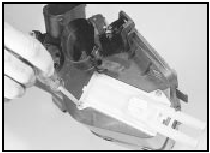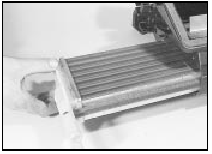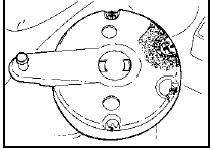Heater unit - overhaul
1 With the heater unit removed from the vehicle, remove the two securing screws and withdraw the heater matrix from the casing (see illustrations).

19.1a Remove the securing screws . . .

19.1b . . . and withdraw the heater matrix
2 Cut the heater casing gasket in line with the casing joint, then use two suitable screwdrivers to prise off the retaining clips and separate the casing halves. Withdraw the lower part of the casing to the side.
3 Remove the air flap valves, then press the control levers from the casing. Note that the “up/down” control lever can only be removed when the marks are aligned as shown (see illustration).

19.3 Heater “up/down” control lever must be aligned as shown before removal
Note that the cross marks are for right-hand drive vehicles
4 Clean all components and hose through the matrix to remove any debris. If necessary use a chemical cleaner to clear the inner passage of the matrix. Renew the components as necessary.
5 Reassembly is a reversal of dismantling.
See also:
Bodywork and fittings
General information
The model range includes 4-door Saloon, 3
and 5-door Hatchback, 5-door Estate, and 2-
door Pick-up body styles.
Each body is of all-steel welded energyabsorbing
monocoque cons ...
Essentials of good fuel economy
Measuring techniques
Your best source of information about actual fuel economy is you, the
driver. You must gather information as accurately and consistently as
possible. Fuel expense, frequency of ...
Air cleaner - removal and refitting
2.0 litre SOHC models
1 Disconnect the battery negative lead.
2 Depress the locking clip on the airflow
meter wiring plug and disconnect the plug.
Pull on the plug, not the wiring.
3 Loosen the s ...
